Candidate Relationship Management: The Complete 2025 Guide
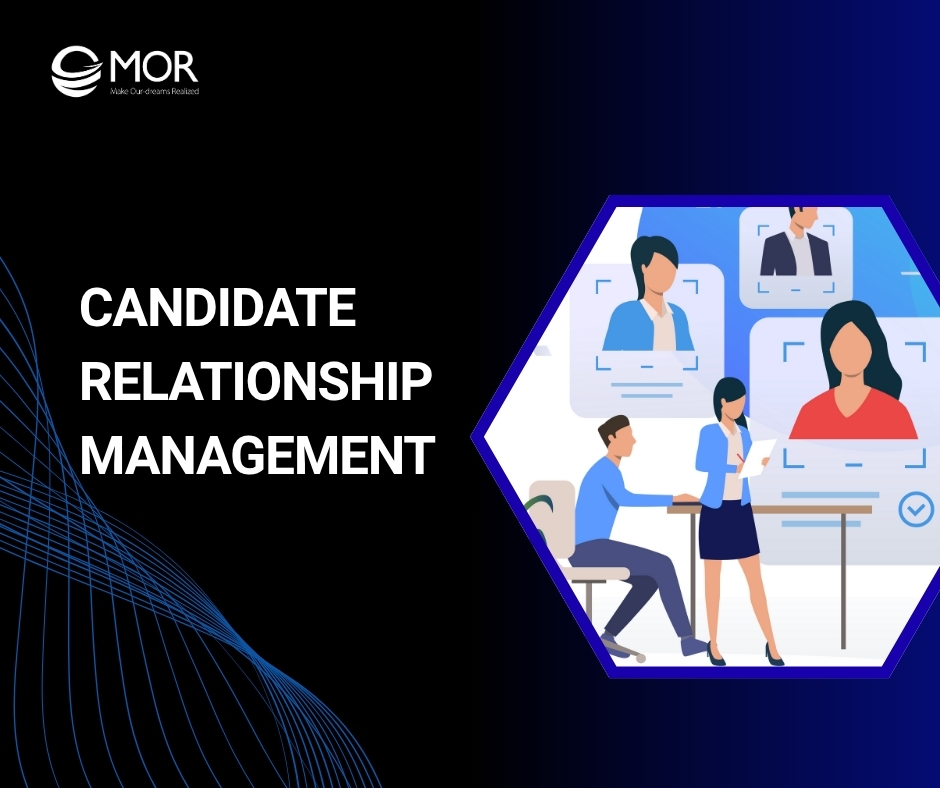
Candidate relationship management has become a must for companies facing hiring delays and talent shortages. This MOR Software’s guide shows how modern candidate relationship management systems help businesses stay connected with top talent, build stronger relationships, and fill roles faster.
What Is Candidate Relationship Management?
Candidate relationship management is a structured way to build and maintain long-term connections with potential hires. Rather than starting every search from zero, recruiters use this approach to create ongoing relationships with skilled professionals who may fit future roles. It’s about nurturing a steady talent pipeline before positions even open, helping companies respond faster when hiring needs arise.
LinkedIn estimates that about 70% of the global workforce is passive, which makes advanced relationship building one of the few reliable ways to reach people who are not actively applying.
Doing this manually can be overwhelming. That’s why most teams turn to candidate relationship management systems designed to automate engagement and track communication. These tools go beyond a traditional applicant tracking system (ATS) by managing relationships with both active and passive candidates. An ATS focuses on current applicants, while a CRM candidate platform keeps track of anyone who has interacted with your employer brand in any capacity.
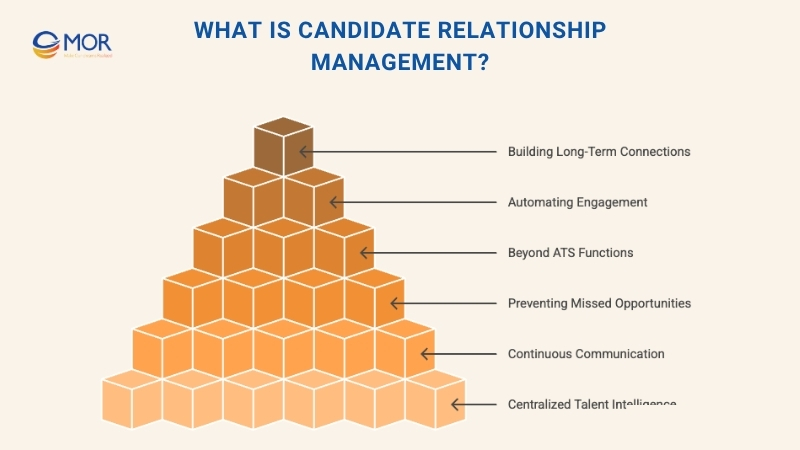
Investing in candidate relationship management software prevents missed opportunities. Without one, valuable candidates who didn’t make it past a specific role may slip away once the position is closed. Those contacts, if managed effectively, could be the perfect fit for future openings. SHRM reports that 47% of HR professionals say recruiting for hard-to-fill roles became somewhat or much more difficult compared with the prior year. This raises the cost of letting qualified finalists disappear from view.
When recruiters rely on spreadsheets or memory, it’s easy to lose touch or follow up too late. A candidate management system eliminates that risk. It turns recruitment into a continuous cycle of communication, where every interaction contributes to a growing and engaged talent network. Teams now interview about 40% more candidates per hire than in 2021, so a CRM helps keep the larger flow of conversations organized and engaged instead of scattered across inboxes.
Ultimately, this system becomes your central hub for talent intelligence. It consolidates all touchpoints, prospects you’ve sourced, applicants you’ve interviewed, and individuals who’ve connected with your brand, into one platform. This way, every new role begins with a strong foundation of known, engaged candidates ready to step in.
>>> Let's explore HRIS integration in 2025, covering common use cases, benefits, challenges, and strategies to build scalable, future-ready solutions!
Benefits Of Candidate Relationship Management
Using candidate relationship management helps companies build stronger, more efficient hiring processes. It turns recruitment from a reactive task into a long-term talent strategy. With the right candidate relationship management tools, recruiters can understand, engage, and retain quality candidates rather than losing them in the process.
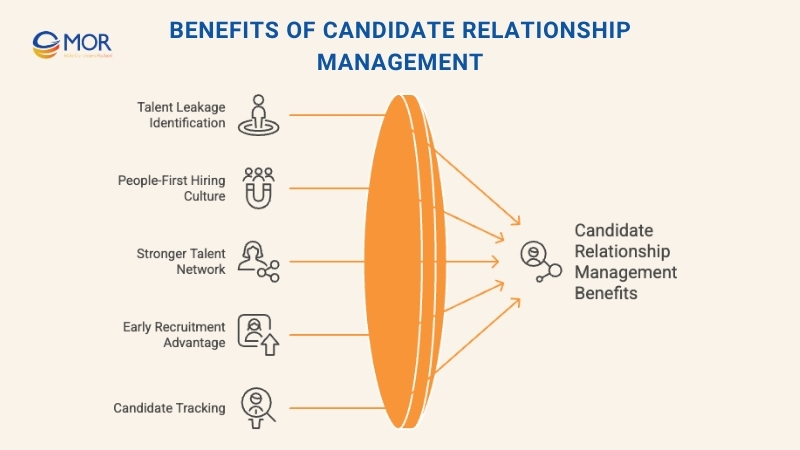
Find Talent Leakages
Talent leakages happen when promising candidates consistently drop out at certain stages of the hiring process. This could include groups with shared traits, like age, gender, or experience level, leaving before the final round. These drop-offs often go unnoticed, yet they represent a major loss of potential talent over time.
One recent analysis found that 57% of candidates abandon an application that feels overly long or complicated, so measuring where and why people exit is essential.
Through staying connected through a CRM talent acquisition platform, recruiters can reach out to these candidates and learn why they disengaged. Were the timelines too long? Was communication unclear? Understanding these gaps helps companies identify weak points in their process and adjust their candidate relationship management strategies accordingly.
Using an AI recruiting automation makes this process measurable and actionable. Recruiters can analyze candidate behavior, track where talent is lost, and refine outreach for better retention. In the long run, addressing these leakages leads to higher hiring success, a fairer recruitment experience, and stronger relationships with potential employees who might otherwise have been forgotten.
Promote A People-First Hiring Culture
A strong candidate relationship management system helps a company show genuine care for its people, not just its goals. Many candidates decline job offers because they sense the company values productivity over well-being. With a thoughtful CRM system, organizations can maintain contact even after the hiring process ends, proving that relationships matter beyond immediate business needs.
Public feedback is important too. 71% of Glassdoor users say their perception of a company improves when it responds to reviews. This shows how ongoing, people-first communication shapes employer reputation.
This kind of consistent follow-up builds trust. It signals that the company values every individual who shows interest, whether hired or not. In industries with high turnover or burnout, like gaming, where long work hours often lead to dissatisfaction, this people-first mindset makes a real difference.
Companies using candidate relationship management software to stay connected demonstrate empathy and respect, setting them apart as employers that treat staff as people, not just resources. It’s a practical way to show that care and culture are part of the business, not afterthoughts.
Build A Stronger Talent Network
Organizations using candidate relationship management gain access to a much broader pool of qualified talent. Every application, interview, or expression of interest becomes part of a long-term hiring resource. Collecting and organizing data from past applicants, recruiters can easily reconnect with people who already showed interest in the company. This turns each hiring cycle into an opportunity to grow a lasting community of potential candidates.
A large, well-managed candidate relationship management database gives companies flexibility and choice when new positions open. The wider the network, the greater the chance of finding exceptional individuals who truly fit the culture and skills needed. Over time, this approach creates a strong competitive edge. Instead of starting every search from scratch, the organization already has an active list of engaged prospects ready for the right opportunity, something that sets it apart from slower, less connected competitors.
Gain An Early Advantage In Recruitment
Using candidate relationship management gives companies a clear head-start in hiring. During the first interaction, recruiters can record a candidate’s interest in future roles across departments. When those positions become available, the team can instantly reach out instead of launching a new recruitment campaign. Because these individuals are already familiar with the brand and process, engagement happens faster and with higher response rates.
This proactive use of CRM for hiring removes unnecessary steps and speeds up recruitment cycles. It helps companies fill positions quickly without sacrificing quality. Workflow automation inside modern recruiting stacks contributes to shorter cycles, and companies that use AI in recruiting have reduced time to hire by 26% on average in global benchmarks.
A well-organized hiring relationship software lets recruiters stay one step ahead, connecting the right people to the right roles before competitors even begin their search. The result is a smoother process, reduced vacancy time, and a team that stays fully staffed and productive.
Track And Reconnect With Potential Candidates
The job market never stands still, and neither do candidates. People gain new skills, certifications, and experiences every year. With candidate relationship management, recruiters can keep up with these changes instead of losing touch once a hiring process ends. Maintaining regular contact helps companies stay informed about how candidates grow in their careers and what new strengths they bring to the table.
This ongoing engagement through recruitment CRM software provides valuable visibility into evolving talent. When tracking career progress, companies can identify when a past applicant becomes a perfect fit for a new opening. Staying close to high performers is especially important because a small share of people drives outsized results, with top talent in critical roles delivering up to 8x the productivity.
In short, businesses that use hiring relationship software to monitor and reconnect with their networks consistently gain an advantage in attracting high-caliber talent and strengthening overall workforce quality.
Top Candidate Relationship Management Tools For 2025
The market for candidate relationship management tools is packed with options, each catering to different recruitment goals. The best approach is to choose recruitment CRM software that aligns with your organization’s needs, whether that’s maintaining a strong talent pool, improving interview coordination, or managing data across teams.
Look for tools that are intuitive, integrate smoothly with your existing CRM recruiting software, and can grow with your business. Demos and free trials are always worth exploring to see which platform fits your hiring workflow best.
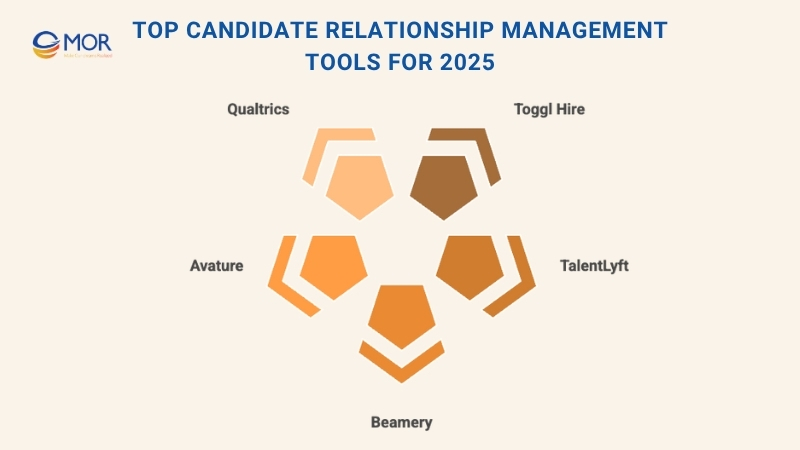
Toggl Hire
Toggl Hire stands out for its simplicity and focus on efficiency. It enables recruiters to screen applicants, evaluate their skills, and instantly filter candidates based on results. This keeps hiring teams focused on high-quality prospects while reducing time spent on manual sorting.
Beyond initial screening, Toggl Hire supports consistent engagement with top candidates. Automated messages deliver feedback and updates with minimal recruiter effort, improving the experience for applicants. The platform also uses gamified assessments, making the process interactive and helping reduce candidate drop-offs, a feature that enhances any candidate relationship management system.
Price: Toggl Hire provides transparent pricing. Recruiters can start with a free account or choose paid plans from $20 per month (billed annually).
TalentLyft
TalentLyft brings together all the essentials of HRM management software in one unified recruiting platform. It gives recruiters full control over the hiring process, from candidate sourcing and tracking applicants to managing marketing campaigns and analyzing recruitment data.
What makes this platform stand out is its ability to expand your reach. TalentLyft connects seamlessly with social media platforms and professional communities like GitHub, making it easier to attract skilled professionals through employee referrals and online engagement.
At its core, TalentLyft functions as both an applicant tracking and candidate relationship management system, enabling HR teams to collaborate on evaluations, schedule interviews, and maintain consistent communication throughout the hiring journey. It’s especially valuable for organizations focused on automation, as it integrates easily with various assessment tools and CRM candidate databases.
Price: A free trial is available. Paid plans start at $73.50 per month, covering two active job posts with unlimited users.
Beamery
Beamery is a sophisticated CRM platform built around advanced talent lifecycle management. It helps recruiters organize, nurture, and activate dynamic talent pools that evolve as business needs change. This makes it a strong fit for companies hiring across multiple roles or industries with shifting skill demands.
One of Beamery’s standout features is its personalized communication tools. Recruiters can connect with candidates directly through WhatsApp or SMS, making outreach faster and more human. Its AI-driven insights also analyze skills and recommend ideal next steps, helping hiring teams tailor every interaction for better engagement.
Simplifying outreach to passive talent and aligning communication with skills-based hiring, Beamery supports modern recruitment strategies that value personalization and precision within candidate relationship management systems.
Price: Beamery provides a free trial, but subscription pricing varies depending on business needs and project size.
Avature
Avature stands out as one of the most flexible systems, offering a fully customizable SaaS platform. Its AI-driven sourcing and marketing tools help recruiters identify, attract, and engage talent, while automated workflows streamline every stage of the hiring journey. This reduces manual work and ensures a smoother experience for both recruiters and candidates.
The platform’s strength lies in its adaptability. HR teams can design unique projects tailored to specific markets or hiring objectives, whether launching referral programs, building DEI-focused campaigns, or creating personalized engagement strategies. With built-in talent mapping and analytics, Avature also provides deeper visibility into workforce skills and market trends.
Its REST API supports seamless integration with ATS platforms and assessment tools, unifying the entire recruitment process. This makes Avature an ideal solution for organizations seeking precision, AI automation, and scalability in their candidate relationship management software.
Price: Avature doesn’t offer a free trial. Pricing is customized based on selected features and company requirements.
Qualtrics
Qualtrics focuses on improving candidate relationship management through experience-driven insights. Its CRM talent acquisition tools allow recruiters to track every touchpoint in the hiring journey, from website visits and job applications to resume screening and interviews. The platform gathers feedback at each stage, helping teams refine their approach and create a smoother, more engaging experience for every candidate.
Turning candidate feedback into measurable data, Qualtrics enables companies to enhance communication, strengthen employer branding, and lower overall hiring costs. It’s a powerful choice for organizations that value data-backed decision-making within their candidate relationship management systems.
Price: Qualtrics is a premium option, priced between $1,500 and $5,000 per year. However, combining its basic plan with other tools like Toggl Hire can provide balanced functionality without overspending.
The Candidate Relationship Management Process
Once you’ve decided that candidate relationship management will play a central role in your hiring strategy, the next step is building a clear process. Investing in the right candidate relationship management systems is only the start, success depends on how well your team organizes, communicates, and maintains engagement with potential talent. Here’s where to begin.
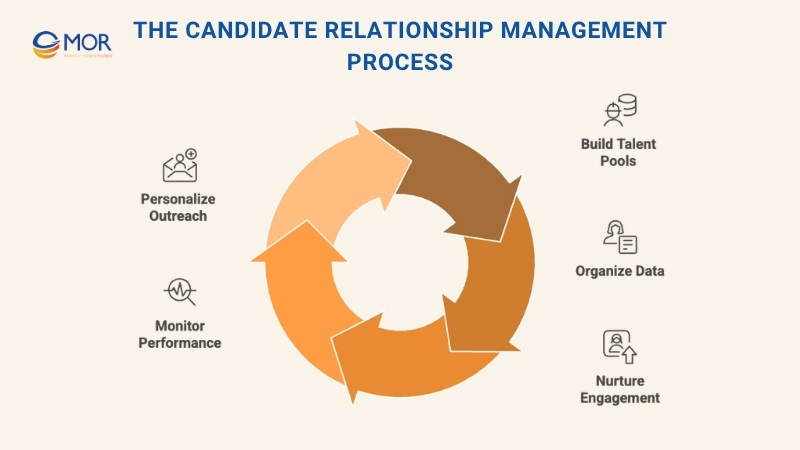
Step 1: Build And Segment Talent Pools
A talent pool, sometimes referred to as a talent community, is a curated group of potential hires who show promise for current or future roles. The idea is to build relationships long before vacancies open, so hiring becomes faster and more intentional.
Your candidate relationship management software should include former applicants who performed well but weren’t hired, passive candidates you’ve engaged with before, individuals who’ve attended your recruiting events, and even former employees or interns. Segmenting these profiles by role, experience, or interest makes it easier to send personalized messages and maintain ongoing communication.
A well-managed hiring relationship software keeps these connections active, ensuring your company always has a pool of pre-qualified, engaged candidates ready to fill open roles.
Step 2: Organize Candidate Data Efficiently
Once your CRM setup is in place, the next priority is keeping everything structured. The quality of your system depends on how well you organize and maintain your data. A detailed, well-classified database makes nurturing and re-engaging talent far easier down the line.
Here’s how to keep your database clean and actionable:
- Build a dedicated pool for your top-tier prospects so you can quickly identify candidates worth re-engaging.
- Segment these pools into stages like “application review,” “mid-stage,” or “final stage.” This helps your team track progress and know exactly where each candidate left off.
- Assign a clear owner for every profile in the CRM recruiting software to maintain accountability and communication flow.
- Always record the last contact made with each candidate in your candidate relationship management software. This ensures personalized, relevant outreach and avoids repetitive messaging.
Proper organization keeps your CRM data meaningful and gives recruiters a complete view of every relationship in progress.
Step 3: Nurture Candidate Engagement Over Time
Building relationships through candidate relationship management doesn’t stop once a role is filled. Keep communication open with prospective candidates, even when you’re not actively hiring. Send periodic updates about company news, events, or industry trends to keep your brand top of mind. Personalized check-ins or newsletters show that your interest goes beyond job openings, helping foster genuine connections over time.
A well-managed hiring HR system integration lets you schedule and automate these touchpoints, ensuring candidates stay engaged without overwhelming your recruiting team. Consistent, thoughtful outreach keeps your talent community active and builds long-term trust.
Step 4: Monitor And Analyze CRM Performance Metrics
The real strength of a candidate relationship management system lies in the data it provides. Use analytics to track engagement, communication patterns, and response rates. These insights reveal how candidates interact with your brand and what kinds of messages drive the best results.
Studying this data, you can refine your CRM candidate strategies, improve follow-up timing, and tailor your messaging to specific audiences. Over time, this data-driven approach strengthens your hiring efficiency and helps you anticipate future recruitment needs with precision.
Step 5: Personalize And Refine Future Outreach
The more you learn about candidates, the more effective your candidate relationship management strategy becomes. Every interaction, an email reply, a social engagement, or a career update, adds valuable context that can shape future communication. Recording these details in your software helps your team craft messages that feel personal and relevant.
Tailor outreach to align with each candidate’s background and interests. For instance, if someone has expertise in a specific programming language or technology, send them updates about new projects or innovations your team is working on. This kind of personalized approach strengthens trust, keeps candidates genuinely engaged, and turns your CRM system into a relationship-building engine rather than just a database.
>>> Explore the top solutions available, understand must-have features, and choose the right visitor management system for hospitals in 2025.
Real-World Examples Of Candidate Relationship Management
Strong candidate relationship management strategies focus on creating lasting, authentic connections with potential hires. Here are a few ways companies put this into practice:
- Personalized Communication: Crafting thoughtful messages that mention a candidate’s name, background, or career interests, showing genuine attention and respect.
- Segmented Talent Pools: Using candidate relationship management systems to group candidates by skill set, experience, or location, making future outreach faster and more targeted.
- Engaging Content: Sharing company news, career advice, or industry insights that keep candidates interested between hiring cycles.
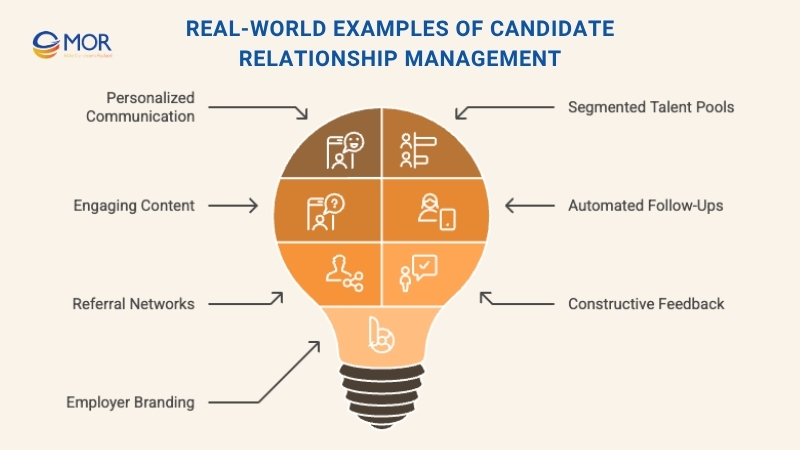
- Automated Follow-Ups: Leveraging CRM software or ATS integrations to send consistent updates and reminders, maintaining regular contact effortlessly.
- Referral Networks: Encouraging employees to recommend talent while keeping communication open with past applicants who might fit new roles.
- Constructive Feedback: Offering useful feedback after interviews to strengthen your reputation and maintain goodwill with skilled professionals.
- Employer Branding: Promoting your values, culture, and team stories across digital channels to attract candidates who connect with your brand’s purpose.
CRM Vs. ATS: How They Differ & Work Together
An Applicant Tracking System (ATS) is designed to manage candidates already in the hiring process. It handles applications, tracks progress, schedules interviews, collects feedback, and manages offers. In short, an ATS focuses on structure and compliance, ensuring every hiring stage runs smoothly from the first application to onboarding.
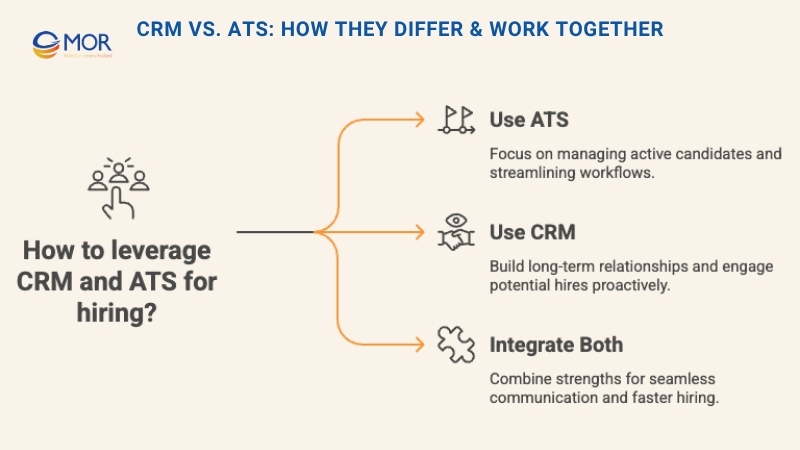
Candidate relationship management, in contrast, centers on engagement and long-term communication. It helps recruiters build relationships with potential hires, whether they’ve applied or not, through personalized outreach, talent segmentation, and automated campaigns. Instead of waiting for applicants, a candidate relationship management system enables a proactive approach that keeps your talent network active and aware of future opportunities.
How They Work Together
When used together, a CRM candidate platform and an ATS create a complete recruiting ecosystem. The CRM software attracts, nurtures, and warms up potential talent, while the ATS organizes and manages active applicants through the hiring stages. Integration between the two ensures smooth data sharing, consistent communication, and better collaboration across teams. This unified setup eliminates duplication, improves candidate experience, and helps recruiters fill roles faster with talent that’s already engaged and informed.
>>> Breaking down what HR risk management means, why it matters, common risk areas, and how to build a plan that protects your people and your business!
Choosing The Right Candidate Relationship Management Solution
When it’s time to adopt a candidate relationship management platform, the goal isn’t just to pick a popular tool, it’s to find one that truly supports your hiring objectives. The best systems align with how your team recruits, communicates, and measures success. Here are key points to consider before making your decision.
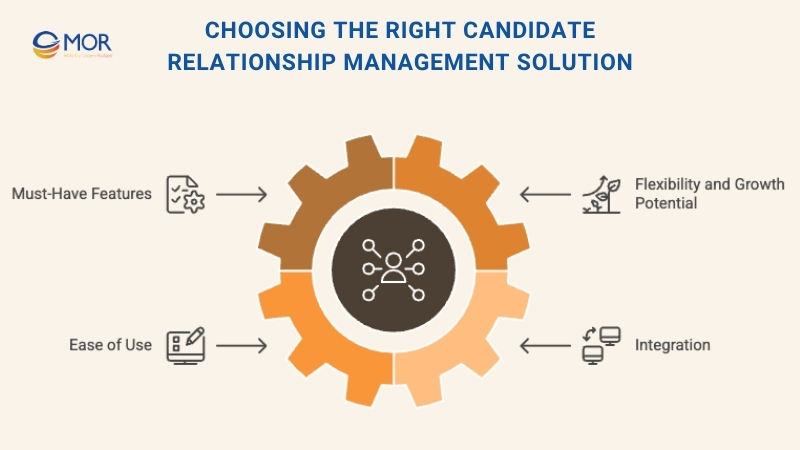
Define Must-Have Features And Core Functions
Start by identifying the essential functions your organization can’t do without. What do you expect this tool to accomplish? Discuss priorities with your recruiters and decision-makers to pinpoint goals like saving time, improving communication, and creating a better experience for candidates.
Your ideal software should support features such as automated messaging, candidate tracking, interview scheduling, and performance analytics. The more these features fit your workflow, the easier it will be to scale your candidate relationship management system and strengthen recruitment outcomes.
Ensure Flexibility And Growth Potential
As your company expands, your candidate relationship management solution should evolve with it. Choose a platform that allows you to customize workflows, fields, and reports to match your hiring structure today while leaving room for future adjustments. A scalable CRM system ensures that your recruitment processes remain efficient, no matter how large or complex your team becomes.
Prioritize Ease Of Use For Recruiters
A tool is only as good as its adoption rate. Your software should be intuitive enough for recruiters to use confidently from day one. Consider whether the interface is easy to navigate, if training will be necessary, and whether mobile access is available for on-the-go recruiting. It’s also smart to involve representatives from HR, IT, and hiring teams during demos to gather feedback and identify potential challenges early on.
Confirm Integration With Existing HR And ATS Platforms
A candidate relationship management system should simplify, not complicate, your operations. Ensure it integrates seamlessly with existing tools like your ATS or HRIS platforms. This connection keeps candidate data synchronized, minimizes manual input, and maintains consistency across all recruiting systems. Smooth integration supports faster workflows and provides a single source of truth for every candidate interaction.
6 Proven Candidate Relationship Management Strategies For Success
A strong candidate relationship management plan doesn’t happen by accident. It requires structure, consistency, and the right technology to keep candidates engaged throughout the entire recruiting lifecycle. We’ll walk you through practical strategies to help your team attract and nurture top talent effectively.
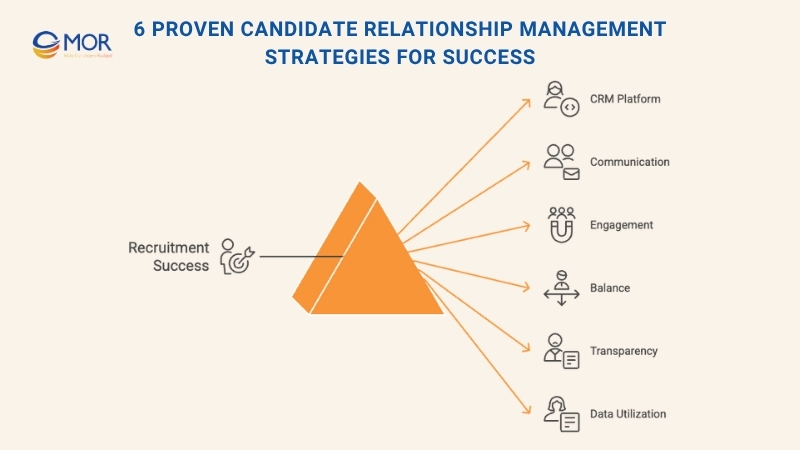
1. Invest In A CRM Platform Built For Recruitment Success
A basic spreadsheet or applicant tracker won’t be enough to compete in today’s hiring environment. You need dedicated candidate relationship management software that allows recruiters to identify, engage, interview, and hire talent in a seamless, repeatable way.
Think of it like a sales or marketing workflow, your team needs tools to deliver the right message, to the right candidate, at the right moment. A modern recruitment CRM system should help you:
- Automate candidate outreach while keeping messages personalized
- Track engagement and send alerts when candidates respond or interact
- Guide prospects through the funnel from first contact to final offer
- Speed up decision-making with real-time insights
- Use tags or filters to organize candidates for future opportunities
- Instantly match profiles to new openings
Before committing, research key features, test demos, and choose a candidate relationship management system that fits your hiring goals and supports your long-term recruitment strategy.
2. Communicate With Candidates Quickly And Personally
Timely, authentic communication is one of the most important parts of candidate relationship management. Candidates value responsiveness, and they notice when companies follow up quickly. In fact, research shows that 57% of job seekers expect a response within three days if they’re not selected, a tough standard to meet manually but easily achievable with the right tools.
Using candidate relationship management software makes it easier to personalize outreach at scale. Instead of sending generic templates, recruiters can craft meaningful one-on-one messages that reflect each candidate’s skills, interests, or past interactions. Modern CRM recruiting software can even automate parts of this process with pre-built templates and customizable workflows.
With the right setup, you can:
- Build targeted email or SMS campaigns that maintain a human tone
- Customize communication by role, department, or seniority
- Adjust timing, frequency, and content for better engagement over time
The best hiring systems foster two-way communication. They encourage candidates to ask questions, share feedback, and stay connected throughout the process. This creates stronger relationships and a more positive perception of your company, even among those who don’t get hired immediately.
3. Keep Candidates Engaged Throughout The Hiring Journey
One of the biggest strengths of candidate relationship management is its ability to maintain engagement across the entire recruitment process. Candidates today often juggle multiple offers, so consistent communication can be the deciding factor between losing or securing top talent.
To keep candidates connected and informed, focus on three key actions:
- Set Clear Expectations. From the first interaction, outline your timeline, next steps, and what candidates can expect. This builds trust and shows professionalism.
- Communicate Consistently. Even if decisions take longer than planned, regular updates through your CRM system prevent silence from eroding interest or confidence.
- Build Ongoing Relationships. Not every applicant will be hired immediately, but a well-managed candidate relationship management platform makes it easy to keep strong candidates in your passive talent pool for future roles.
Keeping communication transparent and steady, you show respect for candidates’ time while reinforcing your company’s reputation as fair, responsive, and people-first, a combination that makes any employer stand out.
4. Balance Active And Passive Candidate Relationship Management
A successful candidate relationship management strategy doesn’t just focus on active applicants, it also builds relationships with passive talent. These are professionals who may not be looking to change jobs right now but are open to the right opportunity. Engaging this group early gives your company an edge when positions need to be filled quickly or require specialized skills.
Recent research shows that while more than 80% of employees feel satisfied in their current roles, around 85% are still open to hearing about new opportunities. That’s a large audience your hiring relationship software can help you reach through consistent, thoughtful engagement.
Here’s how to connect with passive candidates effectively:
- Employee Referrals: Refresh your referral program to keep employees motivated. Offer meaningful rewards, like bonuses or extra time off, and update referrers when their candidates move through the funnel.
- Passive Recruitment Marketing: Use targeted ads, social media campaigns, and content marketing to promote your company culture and upcoming roles where your audience already spends time online.
- Networking Events: Attend conferences, panels, or workshops to meet new professionals face-to-face. These informal interactions build brand familiarity and open the door for future hiring conversations.
Balancing active and passive outreach ensures your software maintains a healthy, engaged pipeline. It keeps your organization visible, approachable, and ready when great talent decides to make a move.
5. Maintain Transparent And Fair Hiring Practices
Strong candidate relationship management goes hand in hand with ethical and transparent hiring. A fair process not only attracts a more diverse range of candidates but also strengthens your reputation as an inclusive and trustworthy employer. Here’s how to put that into practice:
- Be Clear About The Process. From the start, explain what candidates can expect, what to submit, how many steps are involved, and when they’ll hear back. Transparency builds trust and reduces anxiety.
- Showcase Culture And Growth. Go beyond perks and surface-level descriptions. Use your CRM system to share real stories about your company’s long-term direction, career paths, and opportunities for development.
- Minimize Bias. Use structured evaluation templates or anonymized resume reviews to keep the focus on skills and experience rather than personal identifiers.
- Write Honest Job Descriptions. Detailed, accurate listings save time for both recruiters and applicants while improving candidate fit.
- Standardize Interviews. Ask consistent, behavior-based questions and use data from your recruitment CRM software to ensure every candidate gets a fair experience.
- Honor Your Timelines. If hiring takes longer than expected, communicate openly to maintain credibility and respect candidates’ time.
Being transparent and equitable in every interaction fosters lasting goodwill. Candidates remember when they’re treated with fairness, and those experiences often turn them into long-term advocates for your brand.
6. Use Data To Elevate The Candidate Experience
The data inside your candidate relationship management system is more than just numbers, it’s insight you can use to make every candidate interaction better. A smart, data-driven approach helps recruiters understand what’s working, identify areas for improvement, and deliver a smoother experience from start to finish.
Here’s how your candidate relationship management software can guide smarter hiring decisions:
- Utilize built-in analytics and reporting to uncover hiring trends.
- Track key metrics like candidate satisfaction, application completion rates, time to fill, offer acceptance, and drop-off rates.
- Gather and analyze feedback through surveys, follow-ups, and exit interviews.
- Use insights to forecast results, set measurable goals, and fine-tune your candidate relationship management strategies.
All these improvements depend on clean, consistent data. Regular CRM audits and standardized formatting keep information accurate and actionable.
Every recruiter wants a faster, more engaging hiring process, but with limited time, technology becomes the bridge. When your candidate relationship management system supports ongoing communication, feedback analysis, and personalization, it transforms routine recruitment into meaningful relationship-building that attracts and retains top talent.
Build Custom Candidate Relationship Management With MOR Software
At MOR Software, we build tailored candidate relationship management (CRM) solutions that help businesses connect with the right talent more effectively. Each system is designed around your hiring goals, workflows, and long-term growth strategy.
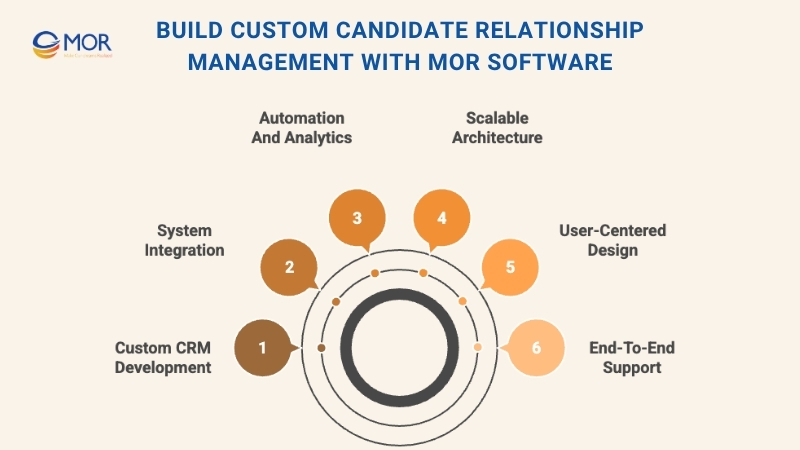
- Custom CRM Development: We design HRM models that match your recruitment process and business objectives.
- System Integration: Our engineers connect CRMs with existing ATS and HR systems to create a unified data flow across all recruitment stages.
- Automation & Analytics: Built-in automation handles candidate nurturing, email tracking, and performance insights to save time and improve decisions.
- Scalable Architecture: Every HRMS software solution supports expansion, handling larger datasets, user groups, and multi-location teams with ease.
- User-Centered Design: Our UX and UI teams craft intuitive dashboards that help recruiters navigate faster and work more efficiently.
- End-to-End Support: From initial consultation to post-launch optimization, we ensure your CRM stays reliable, updated, and aligned with business needs.
Together, these capabilities help companies strengthen relationships with candidates, speed up hiring, and build a recruitment process that lasts.
Conclusion
Building strong relationships with candidates takes more than quick replies, it requires the right technology. With candidate relationship management, your team can connect with top talent, personalize communication, and make smarter hiring decisions. At MOR Software, we develop scalable, data-driven CRM solutions that turn recruitment into long-term engagement. Ready to strengthen your hiring strategy? Contact us today to start building a smarter, more connected recruitment system.
MOR SOFTWARE
Frequently Asked Questions (FAQs)
What is candidate relationship management?
Candidate relationship management is a proactive approach to building and maintaining talent pipelines. Instead of starting from scratch each time a position opens, it focuses on engaging potential candidates early to meet future hiring needs.
What does CRM mean in recruiting?
In recruitment, CRM stands for candidate relationship management. It’s a software system designed to organize candidate data, streamline communication, and strengthen long-term connections with job seekers.
What is the difference between a CRM and an ATS?
An ATS (Applicant Tracking System) manages applicants who are actively in the hiring process. A CRM, on the other hand, nurtures relationships with both active and passive candidates, keeping them engaged even before they apply.
How does a candidate relationship management system work?
A CRM collects and centralizes candidate information, tracks communication history, automates outreach, and helps recruiters manage ongoing engagement through personalized campaigns and talent pools.
Why is candidate relationship management important for businesses?
It helps companies build stronger talent pipelines, reduce time-to-hire, and improve candidate experience. Maintaining relationships also means recruiters can fill roles faster when opportunities arise.
Who uses candidate relationship management software?
Recruiters, HR teams, and talent acquisition managers use CRMs to track candidates, send updates, manage referrals, and analyze engagement metrics across different hiring campaigns.
What are the key features of a recruitment CRM?
Common features include automated messaging, email templates, candidate segmentation, analytics dashboards, integration with ATS, and tools for managing candidate feedback and referrals.
How can candidate relationship management improve the candidate experience?
By keeping communication timely and personalized, candidates feel valued throughout the process. Automated updates, clear next steps, and relevant content all contribute to a positive impression.
Rate this article
0
over 5.0 based on 0 reviews
Your rating on this news:
Name
*Email
*Write your comment
*Send your comment
1